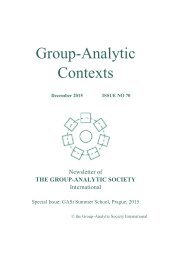Group-Analytic Contexts, Issue 80, June 2018
You also want an ePaper? Increase the reach of your titles
YUMPU automatically turns print PDFs into web optimized ePapers that Google loves.
54 <strong>Group</strong>-<strong>Analytic</strong> Society International - <strong>Contexts</strong><br />
A Third Way of Psychoanalysis: Individual<br />
and <strong>Group</strong> Therapy - Both for one Patient<br />
By Dorothe Türk<br />
Main Idea<br />
The patient should NOT have to fit the treatment, but the treatment<br />
should be adapted to suit the patient’s individual need. Hayne (1999)<br />
called it an “adaptive indication“.<br />
I want to explore the idea that combined therapy is very<br />
helpful and successful, not only for patients with personality<br />
disorders, but also for other patients. Many patients can benefit from<br />
concurrent treatment especially those who are in psychoanalytic<br />
therapy for the first time and for those who are very afraid of joining<br />
a group. In my opinion, in many cases, concurrent treatment is<br />
superior to only individual or group therapy (Türk 2016). I want to<br />
distinguish different ways to practice combined, concurrent and<br />
conjoint treatment:<br />
1. Combined: One individual session is added to one group session per<br />
week; for example, often a few single sessions are necessary during<br />
the first experience of group therapy;<br />
2. Concurrent: <strong>Group</strong> treatment is added to individual psychoanalytic<br />
treatment (for instance, two individual sessions per week and one<br />
group session). Individual treatment is added to group therapy (for<br />
instance, one individual session plus a group session twice a week);<br />
3. Conjoint: Therapy with two psychotherapists working together with<br />
one patient, group therapy with one therapist and individual sessions<br />
with the other therapist;<br />
4. Other: <strong>Group</strong> therapy is started after a completed shorter or longer<br />
time of individual therapy; or individual therapy begins after finishing<br />
group therapy.<br />
Introduction<br />
I have been working in private practice for nearly 20 years. During the<br />
first ten years I only practiced individual psychoanalytic treatment,<br />
patients having normally about 2 to 4 sessions per week. Sometimes<br />
psychoanalytic therapy requires a lot of patience because of the<br />
slowness of the process. I have to admit, sometimes I was bored and













